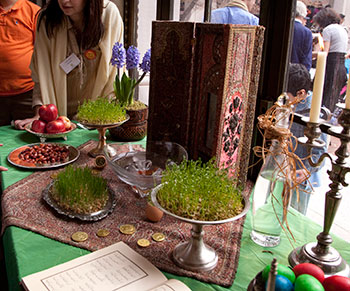 Nowruz Traditions
Nowruz Traditions Nowruz Traditions
Nowruz TraditionsThe Persian word for “new day,” Nowruz marks the beginning of the new year in Iran and many other countries. This period of celebration and rejuvenation coincides with the vernal equinox and the first day of spring. When the sun crosses the celestial equator (the vernal equinox in the Northern Hemisphere), the length of the day and night are the same.
This occasion was celebrated by major cultures in ancient Mesopotamia as early as 3000 BCE. It is rooted in Zoroastrianism, the religion of Iran before the founding of Islam. Today, people in Iraq, Afghanistan, Albania, Turkey, Turkmenistan, Kazakhstan, Kyrgyzstan, India, and Pakistan also participate in the thirteen days of Nowruz with their own local variations of festivities.
In Iranian communities people clean their home, get haircuts, and buy clothes in preparation for the new year. They set up and gather around the beautiful haft sin table, and they cook and enjoy special foods. Friends, families, and neighbors visit with one another and exchange gifts. Young people bring flowers, fruits, nuts, and pastries to adults, while parents and grandparents give their children crisp bills of money in return. As they have done for generations, families and friends celebrate the start of a new year and welcome the return of spring.